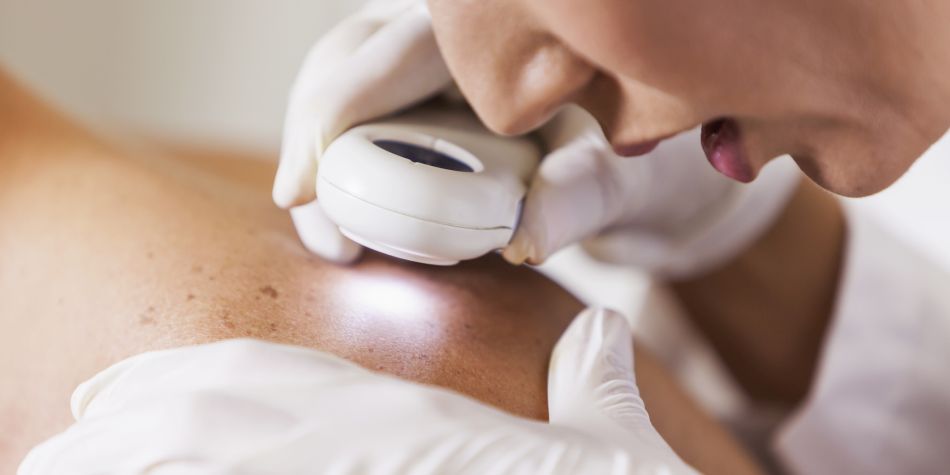
Nothing says sweet summertime like backyard cookouts, pool parties, and trips to the beach. While getting some time outdoors is advised for your overall health, powerful sunrays can be too much of a good thing. Exposure can quickly transition from a nice tan to long term skin damage if you aren’t careful.
In this region, we have nine to ten months of bright sun exposure that can further exacerbate potential skin diseases. Your skin is capable of healing itself from minor injuries by comparing its “master blueprint” called DNA and restoring the skin condition. However, after repeated or high exposure, your DNA gets damaged making it tough to restore your skin to its previous health and luster. When there’s too much damage to the “blueprint,” you can potentially develop skin cancers as your body tries to rebuild while follow instructions from a corrupted blueprint.
Potential worrisome skin blemishes should be evaluated by a professional, but it starts first with a good surveillance of your own complexion. Check for pigmented lesions, sores, or raised areas that you may not recall being prominent previously. Be mindful of exposed areas such as the top of ears, back of the neck, shoulders and even your scalp if you have thinning hair. People with dark complexions should be aware they have risks of developing skin cancers just as easily as those who have fair complexions.
Skin care specialists look for specific changes that we call the “ABC’s.”
- (A)ppearance - does it appear flat, raised, bleeding, waxy, scaly?
- (B)orders - are the edges sharp like a drop of paint or do they look smudged like ink?
- (C)olor- is it reddish, dark pigmentation, skin colored, bluish?
If you are not sure if something needs to be followed closely, you can use your phone under good lighting usually about the distance of a credit card away to snap a pic and compare it again a month or two from then, but if you’re genuinely concerned then see a professional right away!
Many skin lesions are benign, but there are three potentially dangerous skin cancers related to sun damage.
- Basal Cell Cancers – the slowest growing and often thus the least dangerous of skin cancers.
- Squamous Cell Cancers – often appear like a skin colored volcano with an ulcer in the center. These are more concerning because they like to grow wide quickly.
- Melanomas – come from special pigmented cells in your skin. They are worrisome because they can “jump” or metastasize to other parts of your body. Doctors who operate on these kinds of cancer have to perform special surgeries to ensure they get all of the cells because melanomas have a high chance to escape or reoccur.
“An ounce of prevention is worth a pound of cure.” – Benjamin Franklin. It’s best to protect yourself from overexposure.
- Use adequate skin protection such as SPF sunscreen, long sleeves and big floppy hats.
- Mind how much time you spend outdoors
- Pay attention to reflective surfaces such as the water or sand as that can cause not just sunburns but reflect UV rays.
- Don’t forget your sunglasses to protect your eyes from intense rays as well.
Enjoy the summer, beat the heat, and remember your doctor is only a phone call away for any questions!
For more healthy living tips, visit our Healthy Living blog.
About the Author: Dr. Sigismund Lee is a board-certified General Surgeon and the current Chief of Surgery at Memorial Satilla Health. Dr. Lee completed his medical degree at the University of Illinois at Chicago and his internship and residency at Atlanta Medical Center. In April 2009, Dr. Lee relocated to Waycross and has served our community since. Dr. Lee performs a wide range of general surgery cases at Memorial Satilla including imaging guided breast biopsies, lumpectomies, mastectomies and thyroidectomies and is proficient in laparoscopic cases such as cholecystectomies, appendectomies, hernia’s and surgeries of the colon. In his spare time Dr. Lee enjoys playing board games with the Waycross Gaming Community and taking thrill-seeking rides on his motorcycle.
Dr. Sigismund Lee is a board-certified General Surgeon and the current Chief of Surgery at Memorial Satilla Health. Dr. Lee completed his medical degree at the University of Illinois at Chicago and his internship and residency at Atlanta Medical Center. In April 2009, Dr. Lee relocated to Waycross and has served our community since. Dr. Lee performs a wide range of general surgery cases at Memorial Satilla including imaging guided breast biopsies, lumpectomies, mastectomies and thyroidectomies and is proficient in laparoscopic cases such as cholecystectomies, appendectomies, hernia’s and surgeries of the colon. In his spare time Dr. Lee enjoys playing board games with the Waycross Gaming Community and taking thrill-seeking rides on his motorcycle.
$webqFacilityNumber
Need a Physician?